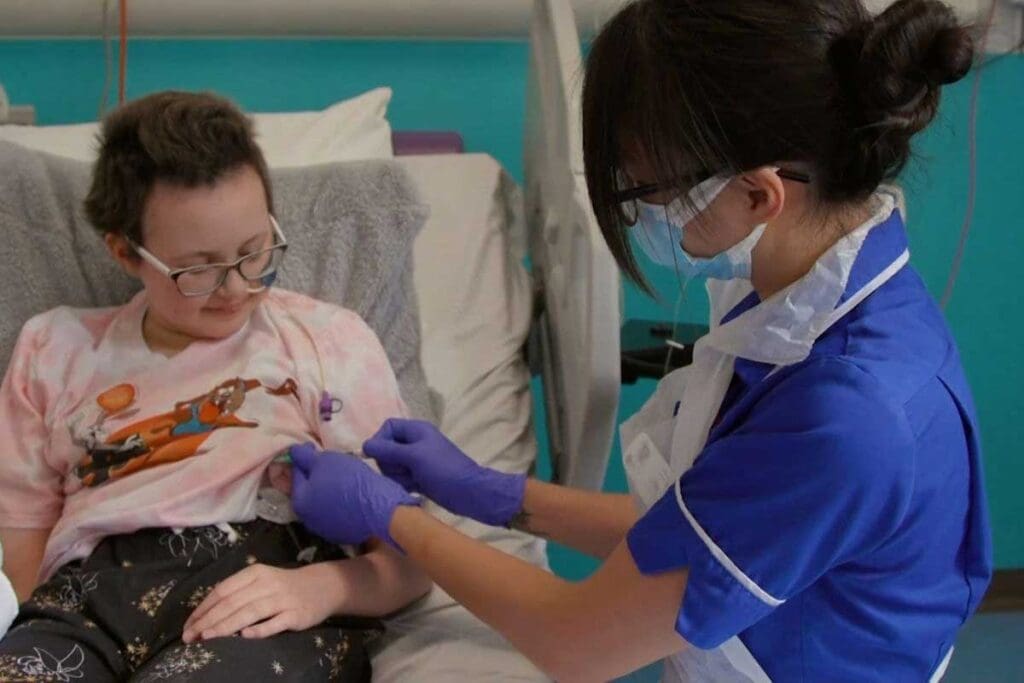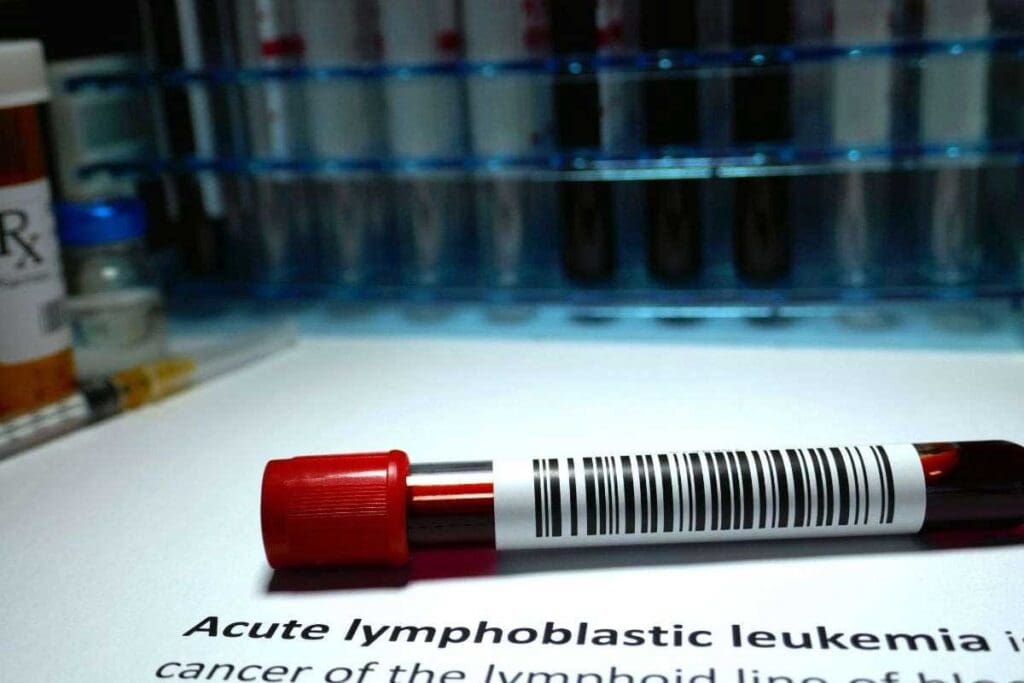Last Updated on November 20, 2025 by Ugurkan Demir

Getting a diagnosis of acute lymphoblastic leukemia in children can be overwhelming for families. At Liv Hospital, we aim to help families understand this condition and its treatment options.
Acute lymphoblastic leukemia in children is the most common type of leukemia in kids, accounting for about 75% of all childhood leukemia cases. Thanks to advances in treatment, children with ALL now have survival rates over 85% in regions with quality healthcare.
At Liv Hospital, we treat our patients like family. In this article, we’ll share essential facts about acute lymphoblastic leukemia in children, including what it is, how common it is, typical symptoms, diagnostic methods, and treatment approaches. We’ll also discuss the unique challenges faced by children of different ages.

Acute lymphoblastic leukemia (ALL) is the most common cancer in kids. It’s important to understand its definition, how it works, and what makes it different.
ALL is a cancer that affects the blood and bone marrow. It happens when immature lymphocytes, a key part of the immune system, grow out of control.
In kids, ALL starts with genetic changes in these lymphocytes. This leads to a buildup in the bone marrow. This buildup stops normal blood cells from being made, causing health problems.
ALL is different from other childhood cancers because it grows fast and has specific genetic changes. Unlike solid tumors, ALL attacks the blood and bone marrow. This makes its diagnosis and treatment special.
The disease can cause symptoms like tiredness, pale skin, frequent infections, and easy bruising. These happen because there aren’t enough normal blood cells.

Acute Lymphoblastic Leukemia (ALL) is the most common cancer in kids. It makes up a big part of cancer cases in children. We will look at how common ALL is, when it happens, what causes it, and where it’s more common.
ALL is behind 75% of all leukemia cases in children. This shows how important it is to know about ALL in kids. Because ALL is so common, scientists are working hard to find its causes and treatments.
ALL mostly happens in kids between 2 and 5 years. It’s more common in kids under 10. Some genetic conditions, like Down syndrome, increase the risk of getting ALL. Also, being exposed to radiation and having certain genetic changes can be risk factors.
ALL is not the same everywhere. It’s more common in some places than others. Developed countries tend to have higher rates. This is due to many reasons, like genetics, environment, and money issues.
| Region | Incidence Rate |
| North America | 4.5 per 100,000 |
| Europe | 4.2 per 100,000 |
| Asia | 3.8 per 100,000 |
Knowing these differences helps us make better health plans. It also helps improve treatment for kids with ALL all over the world.
Acute lymphoblastic leukemia (ALL) in children shows many symptoms. If caught early, it can lead to quick medical help. We’ll talk about the common signs and symptoms of ALL, covering physical, behavioral, and systemic signs.
Children with ALL may show several physical signs. These signs include:
Children with ALL may also show behavioral and systemic symptoms. These include:
Parents and caregivers should know these signs. If they see any, they should get medical help right away. Early diagnosis and treatment are key for children with ALL.
Healthcare providers use many tests to find out if a child has ALL. They check for leukemia and learn about its type. This helps them choose the best treatment.
The first step is a complete blood count (CBC). It looks for odd blood cell counts and shapes. Blood tests can show signs of leukemia, like anemia or too many white blood cells.
These early signs help us decide what tests to do next. For example, finding blasts in the blood points to ALL. This means we need to do more tests to confirm.
A bone marrow biopsy is key to diagnosing ALL. It takes a sample from the hip bone to look for leukemia cells. This test also tells us about the leukemia’s genetics, which helps plan treatment.
Imaging, like X-rays or CT scans, helps see how far the disease has spread. They check for leukemia in other parts of the body, like the brain or spleen.
Risk stratification is important in treating pediatric ALL. It looks at the child’s age, blood cell count, leukemia cell genetics, and how they respond to treatment.
We sort patients into risk groups to choose the right treatment. These groups are standard, intermediate, and high-risk. This helps us pick the best treatment plan.
| Risk Category | Characteristics | Treatment Approach |
| Standard Risk | Age 1-9 years, WBC count | Standard chemotherapy protocol |
| Intermediate Risk | Features between standard and high-risk | Intensified chemotherapy |
| High Risk | Age ≥10 years, high WBC count at diagnosis, adverse genetic features | Aggressive treatment, possibly including stem cell transplantation |
By accurately diagnosing and classifying pediatric ALL, we can give targeted treatment. This improves outcomes for children with this disease.
Modern treatments for childhood ALL have changed the game. We’ve seen big improvements in survival rates and less harm from treatments.
The core of treating childhood ALL is multi-phase chemotherapy. It’s customized for each patient based on their risk level. This method includes:
These steps are designed to be effective yet gentle on the body.
For those with high-risk or relapsed ALL, targeted therapies offer hope. These include:
These targeted treatments show great promise for improving outcomes in high-risk patients.
Stem cell transplantation is considered for high-risk or relapsed ALL patients. This involves:
The choice to do a stem cell transplant depends on the patient’s specific situation and risk level.
By using these modern treatments together, we can give kids with ALL the best shot at a cure. We also work hard to reduce the long-term effects of treatment.
Childhood ALL has seen a remarkable turnaround in survival rates, thanks to contemporary treatment protocols. We have made significant strides in improving the prognosis for children diagnosed with this condition.
In developed countries, the survival rate for children with ALL has exceeded 85%. This shows the big progress in medical care and treatment strategies. It’s thanks to more effective and less toxic therapies.
Multi-phase chemotherapy protocols and targeted therapies have played a big role in improving survival rates. These treatments are made for each patient, leading to better outcomes and a lower chance of relapse.
Several factors influence treatment outcomes in pediatric ALL. These include the genetic characteristics of the leukemia, the patient’s response to initial therapy, and the presence of minimal residual disease. Understanding these factors helps clinicians tailor treatment plans to achieve the best possible outcomes.
Long-term monitoring is essential for children who have undergone treatment for ALL. This monitoring helps detect late effects of treatment and manage any relapses early. We emphasize the importance of complete care in achieving optimal outcomes for these children.
Regular follow-up appointments and screenings are key parts of long-term care. They let healthcare providers tackle any issues quickly. This ensures the best quality of life for survivors of pediatric ALL.
Adolescents and teens with ALL face special challenges. Their journey through diagnosis and treatment is complex. It’s not just about the medicine but also the emotional and social aspects.
Adolescents and teens need treatments that fit their age and disease type. Unlike younger kids, they might get stronger chemotherapy. This can cause different side effects and needs more support.
The treatment for ALL in this age group includes:
Table 1: Comparison of Treatment Protocols for Different Age Groups
| Age Group | Treatment Intensity | Common Therapies |
| Children under 10 | Standard | Chemotherapy |
| Adolescents and Teens | Intensive | Chemotherapy, Targeted Therapy |
| Adults | Variable | Chemotherapy, Stem Cell Transplant |
ALL’s diagnosis and treatment deeply affect adolescents and teens. It disrupts their education, social life, and causes physical changes. This can lead to emotional distress.
“The emotional and psychological impact of cancer on adolescents can be as challenging as the physical aspects of the disease.”
A leading oncologist’s perspective on adolescent cancer care.
Ensuring treatment compliance is a big challenge. The long treatment time and frequent hospital visits can be hard on patients and families.
Comprehensive psychosocial support is key. This includes:
By understanding and tackling these challenges, healthcare providers can offer better care. This improves treatment outcomes and quality of life for adolescents and teens with ALL.
Supportive care is key for kids with ALL. It helps them live better during treatment. It includes managing side effects, preventing problems, and giving emotional and nutritional support.
Preventing and managing complications is a big part of supportive care. This includes:
By tackling these issues early, we can greatly improve outcomes for kids with ALL.
Nutrition is vital for kids with ALL. It helps them stay strong and get through treatment. Strategies include:
Good nutrition can lessen treatment side effects and improve life quality.
Managing pain and keeping life quality up is key in supportive care. This means:
By focusing on pain and quality of life, we make treatment easier for kids with ALL.
Looking at Acute Lymphoblastic Leukemia (ALL) treatment in kids, we see big changes coming. Research is pushing the limits of what we can do to help kids fight leukemia. New treatments and ways to fight the disease are being tested in trials.
Today, kids with ALL get a mix of treatments, including chemotherapy and special drugs. These efforts have made a big difference, with many kids now living well beyond their diagnosis. But, we’re not stopping there. We’re moving towards treatments that are more tailored to each child’s needs.
New treatments and ways to fight leukemia are on the horizon. We’re excited about what’s coming next. With these advancements, we hope to see even better results for kids with ALL. Our goal is to give them the best care and help them live full, happy lives.
Acute lymphoblastic leukemia (ALL) is a cancer that affects the blood and bone marrow. It’s caused by too many immature lymphocytes. It’s the most common leukemia in kids, making up about 75% of cases.
Kids with ALL might show signs like pale skin, bruises, and swollen lymph nodes. They might also act differently or feel tired and have fevers.
Diagnosing ALL in kids involves several steps. First, there’s a screening and blood tests. Then, a bone marrow biopsy and imaging are done. The doctor also figures out the risk level.
Kids with ALL get treated with a mix of chemotherapy phases. For high-risk cases, there are targeted therapies. Sometimes, a stem cell transplant is needed.
Thanks to modern treatments, over 85% of kids with ALL survive in developed countries.
Teens with ALL have special challenges. Their treatment plans differ from younger kids. They also need extra support for their mental health and education.
Supportive care is key in treating ALL. It helps prevent and treat problems, supports nutrition, and manages pain. This keeps the child’s quality of life good during treatment.
Risk stratification is vital in treating ALL. It helps doctors decide the best treatment by identifying who needs more intense or targeted therapies.
Yes, kids need long-term follow-ups to catch any late effects of treatment. This also helps manage any relapses and deal with long-term disease and treatment impacts.
Subscribe to our e-newsletter to stay informed about the latest innovations in the world of health and exclusive offers!